
Tortoises are reptiles of the family Testudinidae of the order Testudines. Like other turtles, tortoises have a shell to protect from predation and other threats. The shell in tortoises is generally hard, and like other members of the suborder Cryptodira, they retract their necks and heads directly backward into the shell to protect them.
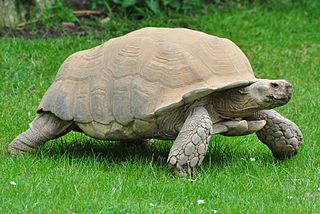
The African spurred tortoise, also called the sulcata tortoise, is an endangered species of tortoise inhabiting the southern edge of the Sahara Desert, the Sahel, in Africa. It is the largest mainland species of tortoise in Africa, and the third-largest in the world, after the Galapagos tortoise and Aldabra giant tortoise. It is the only living species in its genus, Centrochelys, with the five other species in the family already extinct.

The African helmeted turtle, also known commonly as the marsh terrapin, the crocodile turtle, or in the pet trade as the African side-necked turtle, is a species of omnivorous side-necked terrapin in the family Pelomedusidae. The species naturally occurs in fresh and stagnant water bodies throughout much of Sub-Saharan Africa, and in southern Yemen.

The Asian giant softshell turtle, also known commonly as Cantor's giant softshell turtle and the frog-faced softshell turtle, is a species of freshwater turtle in the family Trionychidae. The species is native to Southeast Asia. The species is critically endangered and in the 20th century has disappeared from much of its former range.
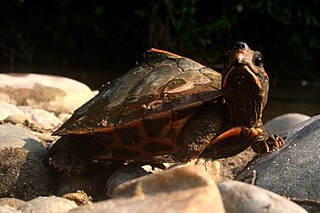
The Assam roofed turtle or Sylhet roofed turtle is a turtle species of the family Geoemydidae found in the Brahmaputra-Meghna drainage in India (Assam) and parts of eastern Bangladesh. It was formerly placed in the genus Batagur and the defunct genus Kachuga.

The red forest duiker, Natal duiker, or Natal red duiker is a small antelope found in central to southern Africa. It is one of 22 extant species form the subfamily Cephalophinae. While the red forest duiker is very similar to the common duiker, it is smaller in size and has a distinguishing reddish coloring. Additionally, the red forest duiker favors a denser bush habitat than the common duiker. The Natal red duiker is more diurnal and less secretive than most forest duikers, so therefore it is easier for them to be observed. In 1999, red forest duikers had an estimated wild population of 42,000 individuals.
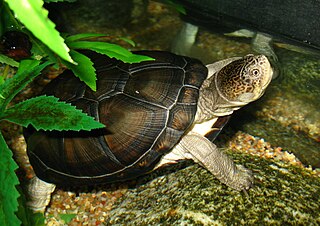
Pelusios is a genus of African side-necked turtles. With 17 described species, it is one of the most diverse genera of the turtle order (Testudines).

The yellow-footed tortoise, also known as the Brazilian giant tortoise, is a species of tortoise in the family Testudinidae and is closely related to the red-footed tortoise. It is found in the Amazon Basin of South America. The species name has often been misspelled as denticulata, an error introduced in the 1980s when Chelonoidis was elevated to genus and mistakenly treated as feminine, an error recognized and fixed in 2017.
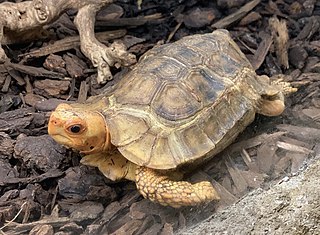
The forest hinge-back tortoise, also known commonly as the serrated hinge-back tortoise or Schweigger's tortoise, is a species of tortoise in the family Testudinidae. The species is indigenous to the tropical forests and marshes of central and western Africa.

Kinixys is a genus of turtles in the family Testudinidae. The genus was erected by Thomas Bell in 1827. The species in the genus Kinixys are native to Sub-Saharan Africa and Madagascar and commonly known as hinged tortoises or hinge-back tortoises.
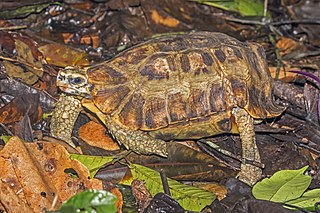
Home's hinge-back tortoise is a species of tortoise in the family Testudinidae. The species is endemic to Africa.

Vittina natalensis, commonly known as spotted nerite or zebra nerite, is a species of small freshwater snail with an operculum, an aquatic gastropod mollusk in the family Neritidae, the nerites. It returns to brackish waters to reproduce. This is a popular aquarium snail, sold because it looks attractive and eats algae in freshwater tanks, but can only reproduce in saltwater or brackish water conditions.

Bell's hinge-back tortoise, also known commonly as Bell's eastern hinged tortoise, is a species of tortoise in the family Testudinidae. The species is native to central Africa. It has the hinge that characterizes all tortoises in the genus Kinixys. There are no recognized subspecies.

The serrated tortoise German: Kalahari-Strahlenschildkröte is a species of tortoise that occurs in the Kalahari desert regions of southern Africa. Also known as the Kalahari tent tortoise, it is one of three members of the genus, Psammobates.
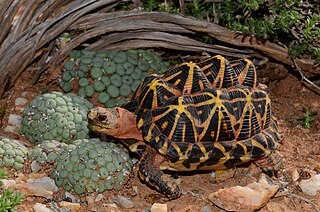
The tent tortoise is a species of tortoise and one of three members of the genus, Psammobates. Known locally as the Karoo tent tortoise, this highly variable species is found in South Africa and Namibia.

The Maputaland-Pondoland-Albany Hotspot (MPA) is a biodiversity hotspot, a biogeographic region with significant levels of biodiversity, in Southern Africa. It is situated near the south-eastern coast of Africa, occupying an area between the Great Escarpment and the Indian Ocean. The area is named after Maputaland, Pondoland and Albany. It stretches from the Albany Centre of Plant Endemism in the Eastern Cape Province of South Africa, through the Pondoland Centre of Plant Endemism and KwaZulu-Natal Province, the eastern side of Eswatini and into southern Mozambique and Mpumalanga. The Maputaland Centre of Plant Endemism is contained in northern KwaZulu-Natal and southern Mozambique.
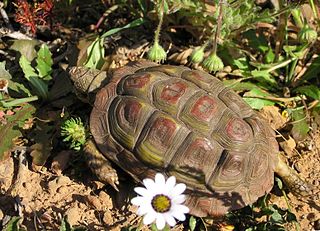
Homopus areolatus, commonly known as the common padloper or parrot-beaked tortoise, is a tiny species of tortoise of the genus Homopus, indigenous to the southern part of South Africa.

Speke's hinge-back tortoise, also known commonly as Speke's hingeback tortoise, is a species of turtle in the family Testudinidae. The species is endemic to Africa.
The Lobatse hinge-back tortoise or Lobatse hinged tortoise is a species of turtle in the family Testudinidae. It is found in Southern Africa.

Homopus femoralis, commonly known as the greater padloper, is a small tortoise of the genus Homopus, indigenous to the highveld grasslands of South Africa.




















